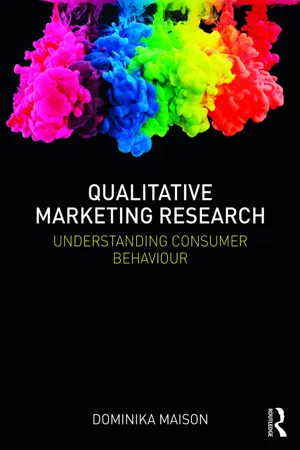Marketing
Market Research
Market research involves gathering and analyzing information about a market, including its size, trends, and customer preferences. This data helps businesses make informed decisions about their products, services, and marketing strategies. Market research can be conducted through various methods such as surveys, interviews, and data analysis to gain insights into consumer behavior and market dynamics.
Written by Perlego with AI-assistance
Related key terms
1 of 5
11 Key excerpts on "Market Research"
- Ronald A. Nykiel(Author)
- 2007(Publication Date)
- Routledge(Publisher)
PURPOSE Marketing research is the active process of identifying and gathering information pertinent to assisting in the decision-making process. The type of information gathered for analysis is de- pendent upon the purpose of the research. In addition there are a variety of research methodolo- gies and information-gathering processes utilized by Market Researchers. One definition of marketing research is that it is the “function that links the consumer, customer, and public to the marketer through marketing information.” 1 * However, this is but one of many different defini- tions. Frequently, businesses want to know what the market for a specific product is or service before it can be sold to the consumer. And, frequently the term Market Research is used to de- scribe the process of identifying and gathering information related to the specific product or ser- vice. In this latter case the focus is on consumer demand, product and/or service supply, the present and future scenarios, and many other factors that can impact the decision process. Again, the type of information gathered for analysis is dependent upon the purpose of the re- search. The purpose of the research can be focused on analyzing customer needs, product/service at- tributes, competitors’ strengths and weaknesses, and even external events likely to impact the product or service offering. The research might focus on the product/service offering in terms of supply and demand, both current and future. The research may focus on actual markets, coun- tries, and cities, seeking to identify opportunities for or threats to an existing product/service offering. Research may focus on new product/service development by identifying market seg- ments or product/service offerings currently not being served. Handbook of Marketing Research Methodologies for Hospitality and Tourism © 2007 by The Haworth Press, Inc.- eBook - PDF
- Carl McDaniel, Jr., Roger Gates(Authors)
- 2020(Publication Date)
- Wiley(Publisher)
Marketing Research and Decision Making 3 Marketing Research and Decision Making Marketing research plays two key roles in the marketing system. First, as part of the market- ing intelligence feedback process, marketing research provides decision makers with data on the effectiveness of the current marketing mix and offers insights into necessary changes. Second, marketing research is the primary tool for exploring new opportunities in the mar- ketplace. Segmentation research and new product research help identify the most lucrative opportunities for a firm. Marketing Research Defined Now that you have an understanding of how marketing research fits into the overall market- ing system, we can proceed with a formal definition of the term, as stated by the American Marketing Association: Marketing research is the function that links the consumer, customer, and public to the marketer through information—information used to identify and define marketing opportunities and problems; generate, refine, and evaluate marketing actions; mon- itor marketing performance; and improve understanding of marketing as a process. Marketing research specifies the information required to address these issues, designs the method for collecting information, manages and implements the data collection process, analyzes the results, and communicates the findings and their implications. We prefer another definition: Marketing research is the planning, collection, and anal- ysis of data relevant to marketing decision making and the communication of the results of this analysis to management. Importance of Marketing Research to Management Marketing research can be viewed as playing three functional roles: descriptive, diagnostic, and predictive. Its descriptive function includes gathering and presenting statements of fact. What is the historic sales trend in the industry? What are consumers’ attitudes and be- liefs toward a product? Opening a pack of bacon is a messy job. - eBook - ePub
- Paul Reynolds, Geoff Lancaster(Authors)
- 2005(Publication Date)
- Routledge(Publisher)
Marketing Information and Research
DOI: 10.4324/9780080455020-1414.1 Introduction
The American Marketing Association (AMA, 1961 , p. 1) defines marketing research as: ‘the systematic gathering, recording and analysing of data relating to the marketing of goods and services’. Kotler (1994 , p. 257) defined it as: ‘systematic problem analysis, model building and fact finding for the purpose of improved decision-making and control in the marketing of goods and services’. Doyle (1994 , pp. 39, 124) stated that marketing management consists of five tasks, one of which is marketing research and explains: ‘Management has to collect information on the current and potential needs of customers in the markets chosen, how they buy and what competitors are offering’.Research attempts to find reliable and unbiased answers to questions. Marketing research provides information in a systematic way about the markets for goods and services and probes people’s ideas and intentions on many issues. As explained in Chapter 2 , in a complex consumer society, there is little direct contact between producers and consumers. Marketing research can, by the collection, analysis and interpretation of facts, find out what it is that people want and ascertain why they want it. The application of techniques and methodology of marketing research are as applicable in the not-for-profit sector as in profit-making organisations.14.2 Marketing Information Systems
Effective marketing decisions are as good as the information on which they are based. Decision-making underlies the management process at every level and the terms ‘managing’ and ‘decision-making’ are synonymous. Marketing management is the process of making decisions in relation to marketing problems. Marketing research is utilised by marketing management when planning the marketing strategy of an enterprise. A disciplined and systematic approach to research methodology to the area of investigation is needed and a series of steps should be taken in developing, planning and executing research with a view to solving specific problems (Demirdjian, 2003 - eBook - PDF
- Wolfgang Donsbach, Michael W Traugott, Wolfgang Donsbach, Michael W Traugott(Authors)
- 2007(Publication Date)
- SAGE Publications Ltd(Publisher)
50 Marketing Research H u m p h r e y T a y l o r What exactly is marketing (or market) research? In what ways is it the same as or different than opinion polling? Chuck Chakrapani (2000, pp. 4ff.) wrote that: ‘Traditionally, marketing research has been considered a discipline that primarily uses scientific methods to collect, analyze, and interpret data relevant to marketing of goods and services.’ But he went on to say that: The acceptance of this definition has prevented marketing researchers from being meaningful part-ners in the decision-making process. The practice and goal of marketing research should not be just to provide ‘input’ to decision makers but to gather data and interpret them in light of what is already known and to be a part of the decision-making process. To have continued relevance to management and marketing, we should develop a core body of knowledge. Such knowledge should be supported by extensive empirical evidence. There is no substitute for empirical evidence. Statistical analysis on limited data cannot take the place of empirical evidence. This is an excellent description of marketing research at its best. However, marketing research certainly includes both quantitative and qualitative research, and qualitative research, by definition, does not provide data for ‘extensive empirical evidence.’ Marketing research draws on many different sources for its data, including primary (i.e. ‘new’) research and secondary research (the analysis of data and other information already available). It does not necessarily involve the use of new data collection, although it usually does. It includes both consumer (actual or potential retail customers) research and business-to-business (‘B2B’) research where corporate or institutional customers or prospects are interviewed. Like opinion polling, marketing research may be conducted locally, regionally, nationally or internationally. - eBook - PDF
- Joao Heitor De Avila Santos(Author)
- 2020(Publication Date)
- Society Publishing(Publisher)
In Market Research, processes such as surveys and interviews are conducted to identify consumer needs so that by analyzing that data it will become easier for the production department to start working on a product. This analysis result allows the production team to have a piece of in-depth information related to the product and service required to be developed. For the efficient use of collected data, it is very essential to have a good communication process among different departments of a business. Marketing research finds aspects related to consumer behavior, such as how a consumer decides to buy a certain product. These days e-commerce business is on the rise and almost every business organization have their online presence. They use various tactics to make consumer buy products from their brands. However, it is a long process in which the first step is consumer behavior research. However, in the case of online business, a huge amount of data is present that requires thorough analysis. This analysis of data shows the buying patterns of the customer and how they chose to buy products. The analysis also allows the organization to have a piece of information regarding why consumers chose a product and leave without buying it. All this information allows the organization to develop marketing strategies to have better sales Consumer Behavior and Culture 100 performance. The sales of the organization increase when the customer-centric approach is used by the business organization. Marketing research has become one of the most essential aspects of business due to the presence of various businesses selling similar products. This has allowed the customers to buy from different brands as per their like and buying capacity. Thus, due to the presence of different brands selling the same product makes the organizations to find how they can attract customers to buy the product from their brand. - eBook - ePub
Qualitative Marketing Research
Understanding Consumer Behaviour
- Dominika Maison(Author)
- 2018(Publication Date)
- Routledge(Publisher)
1 Why we need qualitative research methods The role of research in marketing Data-based marketing decisionsMarketing department staff, their heads of departments, and brand managers are constantly called upon to make a wide variety of decisions aimed – in short – at the growth in sales of the manufactured products. This apparently simple case is actually extremely complicated mainly because there is a plethora of factors that can affect the rise or decline in sales. The sale of a product is affected by factors related to the product like the packaging, name, promotion, communication, advertising, price and, of course, the quality of the product, as well as many other external factors like the exposition of the product in the store or the activities of the competition. This is why marketing staff are in constant search of support for their decisions in consumer knowledge and this is exactly what marketing research is intended to facilitate.Marketing research started to become more important when the market became saturated with products with very similar parameters (Alase, 2017; Bailey, 2014; Jeffrey, 2010). This required an assessment of the market needs and consumer preferences so as to aptly adjust production and marketing communication to these expectations and gain a significant market advantage. However, the proper harnessing of information obtained from Market Research is not so simple a task as it may seem and a lot depends on grasping its specific role in making marketing decisions. First, it’s important to bear in mind that consumer research should never be the only source of information but one of many different sources. When a marketing employee makes a decision concerning a change in packaging, for instance, he or she has to take into account not just the outcomes of marketing research (which may reveal a preference for one packaging option), but lots of other information like the packaging of the competition, in order to know whether or not the packaging will stand out. Apart from that, the production possibilities, costs, and distribution are also important for the new packaging – despite being attractive and standing out – to not impede transport. - Tony Curtis, John Williams(Authors)
- 2012(Publication Date)
- Routledge(Publisher)
- How are pay-offs associated with promotional efforts estimated?
Market information- How is marketing research information transmitted to, and used within, the business unit?
- Is a global information system in place?
- How are tasks scheduled, described and planned? How are the responsibilities of individuals determined?
- What spans of supervision, reporting relationships and communication patterns exist? How are they evaluated?
- What level of competence has been attained by personnel in each position?
- Are remedies to problems, if necessary, being planned? What are they?
- What is the state of morale? motivation? What are the present plans in these areas?
- Describe career development paths. Have potential replacements for personnel in key positions been identified?
The term ‘marketing research’ covers Market Research, marketing research, product research and research to support pricing, distribution and promotional activity. Market Research is used to supply information about the market for particular products and services. Therefore, Market Research has a narrower focus compared to marketing research.Market Research Characteristics of Good Market Research- Scientific method– The principles are careful observation, formulation of hypotheses, prediction and testing.
- Research creativity– Research should develop innovative ways to solve a problem.
- Multiple methods– The research should use more than one method to increase confidence in the results.
- Interdependence of models and data– A recognition that data is interpreted from underlying models that guide the type of information sought.
- Value and cost of information
- eBook - PDF
- Greg Elliott, Sharyn Rundle-Thiele, David Waller, Ingo Bentrott, Siobhan Hatton-Jones, Pete Jeans(Authors)
- 2020(Publication Date)
- Wiley(Publisher)
Pdf_Folio:83 CHAPTER 3 Market Research 83 The underlying detail should also be provided to support the recommendations. The recommendations ultimately lead to a marketing decision, which in turn will lead to marketing outcomes. Ideally, the outcomes are a successful response to the research problem that triggered the Market Research process. KEY TERMS big data Integration of data from across sectors and collaborating partners. causal research Research that assumes that a particular variable causes a specific outcome and then, by holding everything else constant, tests whether the variable does indeed effect that outcome. descriptive research Research used to solve a particular and well-defined problem by clarifying the characteristics of certain phenomena. exploratory research Research intended to gather more information about a loosely defined problem. hypothesis A tentative explanation that can be tested. Market Research A business activity that discovers information of use in making marketing decisions. Market Research brief A set of instructions and requirements that generally states the research problem and the information required, and specifies the timeframe, budget and other conditions of the project. marketing information system (MIS) The structure put in place to manage information gathered during the usual operations of the organisation. non-probability sampling A sampling approach that provides no way of knowing the chance of a particular member of the population being chosen as part of the sample that will be studied. population All of the things (often people) of interest to the researcher in the particular research project. primary data Data collected specifically for the current Market Research project. probability sampling A sampling approach in which every member of the population has a known chance of being selected in the sample that will be studied. - Callie Daum, Vibrant Publishers(Authors)
- 2020(Publication Date)
- Vibrant Publishers(Publisher)
Another way of collecting information is by simply watching what the competitors do and taking note. Some organizations will purchase a competitor’s product and take it apart to reveal its advantages and disadvantages. After noting what works and what does not, the competitor will attempt to improve upon the existing competitor product.Often people who work with competitors are good sources of competitive information. If a customer works with a competitor frequently, he or she can inform your organization on the latest happenings of the competitor. Sometimes, companies will go as far as sending a “spy” to gather information on competitors. There is obvious ethical question to this method that your organization will need to answer internally before considering this option. Job interviews or discussions with competitor staff may also yield valuable information.The Process of Marketing Research
The final information category is marketing research. Marketing research focuses on link the consumer or customer to the organization, specifically the marketing manager. Linking the two allows organizations to gather information to help them determine their opportunities and issues, to review marketing actions, understand how well they are performing, and increase comprehension of the marketing process.Below is a diagram indicating the marketing research process. This process is what marketing researchers follow.What’s the Problem and the Objective?
The first step in the marketing research process is to ask the question, “What is the problem I am trying to solve and what is my objective?” Clear understanding of the answer to this question by the researcher and the manager are critical to obtaining relevant information that will affect decision making. Some describe this step as the most difficult of all the steps in the process because there are instances where you know the problem, but you do not know its cause. When you have instances such as these, it is helpful to understand the most common objectives for marketing research.- eBook - PDF
Standing Room Only
Marketing Insights for Engaging Performing Arts Audiences
- J. Bernstein(Author)
- 2017(Publication Date)
- Palgrave Macmillan(Publisher)
C H A P T E R 7 Conducting and Using Marketing Research Historically, managers have devoted most of their attention to managing their products, their money, and their people, while paying less attention to another of the organization’s critical resources: information. The need for mar- keting research information is greater now than at any time in the past. Said economist Joseph Steiglitz, “What you measure affects what you do. If you mea- sure the right thing, you do the right thing.” 1 As marketing segmentation strate- gies become more sophisticated, segments become smaller, and people expect increasingly individualized service, organizations need to learn more about the needs and wants of their various target markets. Also, as consumers have become more selective and demanding in their buying behavior, sellers find it harder to predict buyers’ responses to different features, benefits, packaging options, and other attributes unless they turn to marketing research. This need for informa- tion has grown over recent years with the emergence of sophisticated technolo- gies that have revolutionized information handling and have made it accessible to and inexpensive for even the smallest organizations. The amount of data in our world has been exploding, and analyzing large data sets—so-called big data—is a function that leaders in every sector will have to grapple with, not just a few data-oriented managers, according to research by MGI and McKinsey’s Business Technology Office. 2 The increasing volume and detail of information captured by enterprises, the rise of multimedia, social media, and the Internet will fuel exponential growth in data for the foresee- able future. All this rich data has enabled and required businesses to move from managing relatively large market segments to treating each individual as his or her own segment. - eBook - PDF
- (Author)
- 2008(Publication Date)
- Wiley(Publisher)
We can, therefore, think of Market Research as a process that starts with an understanding of the scientific principles that would define the “ideal” study. But then the process becomes subject to a series of pragmatic trade-offs necessitated by various practical commercial, and cost considerations. Thus, the experienced researcher knows how to compensate for the departure from the “ideal” study to the pragmatic research design trade-off that was eventually selected. Building Up the Picture through Exploratory Research Most Market Research projects start with someone in an organisation asking a question about something that they do not know about in the expectation that some form of information – rather than using guess work – may help shape a more informed decision. This questioning process The Role and Changing Nature of Marketing Intelligence 17 may follow the “classic” form of setting up a working hypothesis, that will then be “tested” by the research. But more often than not researchers will respond by getting under way with a “working view” of the topic under investigation and use this as a starting point for the research. For example, if we were asked to improve customer service at a hotel, researchers will often get the investigative process under way by reviewing, from their own personal experience, the best and worst hotel experiences they have encountered. This initial “view of the world” will trigger the investigative process. Looking for Clues So, at the beginning of most studies, the researcher will assemble little clues and snippets of information. These will be obtained by reading various industry reports, checking available sources on the Internet, looking at past customer research reports, and informally talking to people about their own “anecdotal” experiences.
Index pages curate the most relevant extracts from our library of academic textbooks. They’ve been created using an in-house natural language model (NLM), each adding context and meaning to key research topics.










